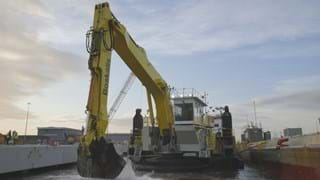To accommodate an assembly plant for wind turbines, a 220 m quay wall had to be added to the existing quay and two hectares of land behind the new quay had to be reclaimed.
In anticipation of offshore wind farm developments in France, the Port Authorities of Cherbourg and Caen-Ouistreham have decided to expand their ports to accommodate this industry.
Project specifications
A specific contract requirement for the quay wall and terminal was the bearing capacity of 15 t/m2 and the maximum allowed settlement of 3 cm under a load of 15 t/m2. Two berth pockets were constructed at the same time: one with a water depth of 14 m and the other with a depth of 10 m. A turning circle in front of the new quay was dredged to a depth of -12 m. In the joint venture, Soletanche-Bachy was responsible for all the civil-engineering work and Atlantique Dragage was in charge of the marine work. The execution of the project was divided in four stages:
- Dredging of turning circle and both berth pockets. The dredged materials were designated for the construction of a temporary bund, needed to build the diaphragm walls (quay wall and anchor wall);
- Construction of the quay wall;
- Removal of the temporary bund on the outside of the new quay wall. The dredged materials to be used for the reclamation of a new terminal behind the constructed quay;
- Testing and hand-over of the work.

